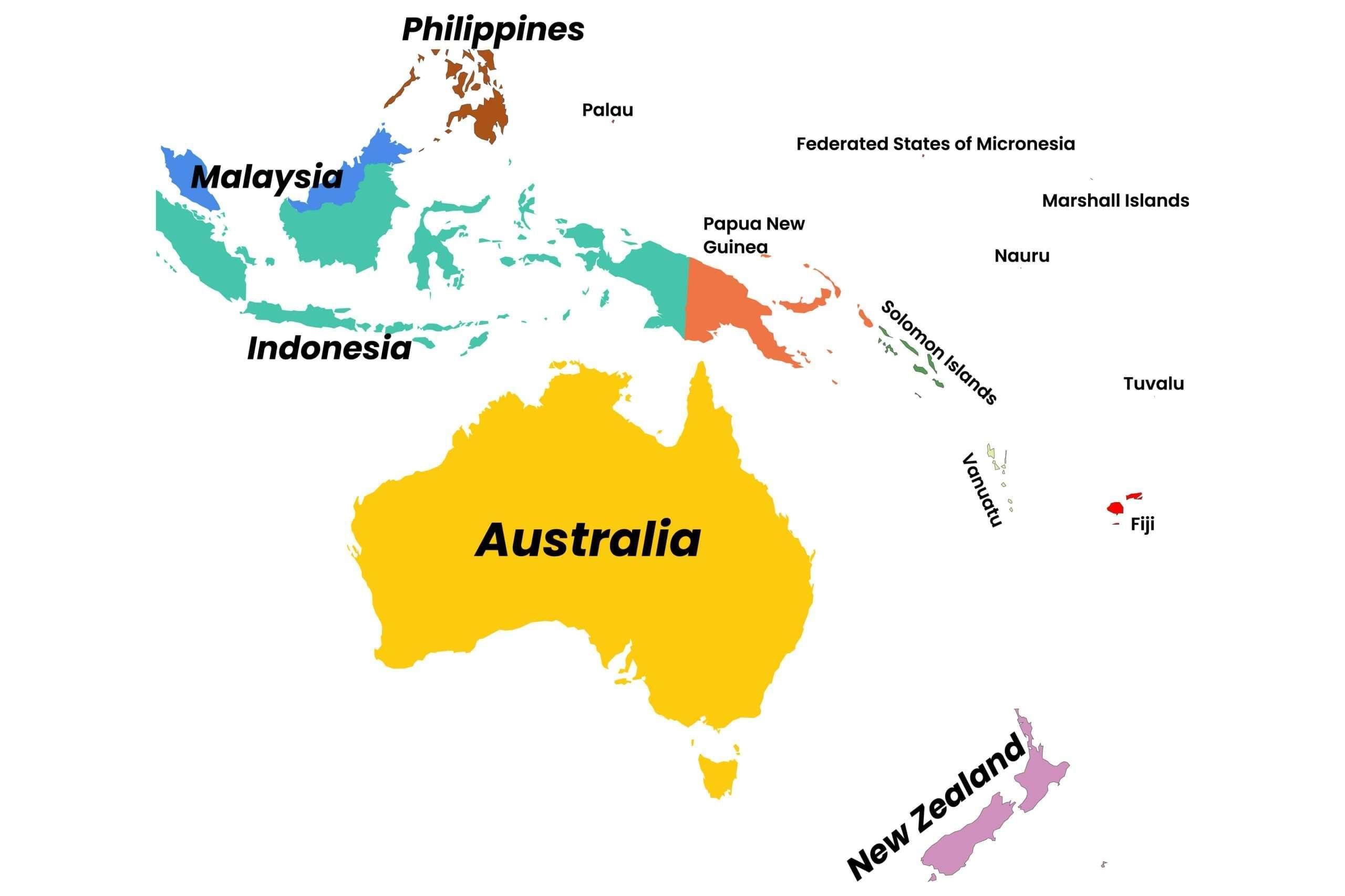Grade 7 Exam > Grade 7 Notes > Social Studies for Grade 7 > Chapter Notes: Oceania: Geography
Oceania: Geography Chapter Notes | Social Studies for Grade 7 PDF Download
Introduction
Oceania is a region in the Pacific Ocean that includes many islands and countries. It is known for its beautiful landscapes, unique animals, and diverse cultures. This chapter will help you learn about the countries in Oceania and their special features. You will discover where these countries are located and important facts about each one.
Identify and Select Countries of Oceania

- Oceania is a region made up of thousands of islands in the Pacific Ocean.
- It includes 14 independent countries.
- The countries are spread across a large area of the Pacific Ocean.
- Oceania is divided into four main regions:
- Australasia: Includes Australia and New Zealand.
- Melanesia: Includes islands like Papua New Guinea and Fiji.
- Micronesia: Includes small islands like Nauru and Palau.
- Polynesia: Includes islands like Samoa and Tonga.
- Australia is the largest country in Oceania and is also a continent.
- New Zealand is made up of two main islands, North Island and South Island.
- Papua New Guinea is known for its dense forests and many languages.
- Fiji is famous for its beaches and coral reefs.
- Smaller countries like Nauru and Tuvalu have very small land areas.
- Each country in Oceania has its own unique culture and history.
- The countries are located in different parts of the Pacific Ocean, from near Asia to near the Americas.
- Some countries are made up of many islands, while others are single islands or landmasses.
- Oceania also includes territories controlled by other countries, but we focus on independent countries here.
Name Countries of Oceania

- There are 14 independent countries in Oceania.
- Each country has its own capital city and unique features.
- List of countries and their capitals:
- Australia: Capital is Canberra.
- It is the largest country in Oceania.
- Known for the Outback, kangaroos, and the Great Barrier Reef.
- New Zealand: Capital is Wellington.
- Made up of North and South Islands.
- Famous for its mountains and Maori culture.
- Papua New Guinea: Capital is Port Moresby.
- Has many forests and over 800 languages.
- Located north of Australia.
- Fiji: Capital is Suva.
- Made up of over 300 islands.
- Known for beaches and coral reefs.
- Samoa: Capital is Apia.
- Located in Polynesia.
- Famous for its traditional Polynesian culture.
- Tonga: Capital is Nuku’alofa.
- A kingdom with many islands.
- Known for its friendly people and beaches.
- Vanuatu: Capital is Port Vila.
- Has active volcanoes and tropical forests.
- Located in Melanesia.
- Solomon Islands: Capital is Honiara.
- Made up of many islands in Melanesia.
- Known for its coral reefs and World War II history.
- Kiribati: Capital is Tarawa.
- Has many small islands spread across a large area.
- Located in Micronesia and Polynesia.
- Marshall Islands: Capital is Majuro.
- Made up of small coral islands.
- Located in Micronesia.
- Micronesia (Federated States of Micronesia): Capital is Palikir.
- Has four main island groups.
- Known for its beautiful lagoons.
- Palau: Capital is Ngerulmud.
- Has over 200 islands in Micronesia.
- Famous for its underwater coral reefs.
- Nauru: Capital is Yaren.
- One of the smallest countries in the world.
- Located in Micronesia.
- Tuvalu: Capital is Funafuti.
- A small country with nine islands.
- Located in Polynesia.
- Australia: Capital is Canberra.
- These countries vary in size, from large Australia to tiny Nauru.
- Each country has its own government and way of life.
- Some countries, like Kiribati, are spread across a huge area of the ocean.
- Many countries rely on the ocean for fishing and tourism.
The document Oceania: Geography Chapter Notes | Social Studies for Grade 7 is a part of the Grade 7 Course Social Studies for Grade 7.
All you need of Grade 7 at this link: Grade 7
FAQs on Oceania: Geography Chapter Notes - Social Studies for Grade 7
| 1. What are the main countries in Oceania? |  |
Ans. The main countries in Oceania include Australia, New Zealand, Papua New Guinea, and several island nations such as Fiji, Samoa, Tonga, and Vanuatu. Additionally, there are territories like French Polynesia and Guam that are part of this region.
| 2. What is the geographical significance of Oceania? |  |
Ans. Oceania is significant geographically due to its vast expanse of the Pacific Ocean, consisting of thousands of islands. It serves as a bridge between Asia and the Americas, and its diverse landscapes range from tropical rainforests and volcanic islands to arid deserts, making it home to unique ecosystems and cultures.
| 3. How does Oceania's climate vary across its countries? |  |
Ans. Oceania's climate varies widely, with tropical climates in the northern islands, temperate climates in New Zealand and southern Australia, and arid conditions in parts of Australia. Different regions experience distinct weather patterns, including monsoons in some areas and subtropical conditions in others.
| 4. What cultural diversity exists among the countries in Oceania? |  |
Ans. Oceania is culturally diverse, with numerous indigenous groups and languages. For instance, Australia is home to Aboriginal cultures, while Polynesian cultures are prevalent in places like Samoa and Tonga. Each country has its unique traditions, languages, and social structures, contributing to the rich tapestry of Oceania's heritage.
| 5. How do the countries of Oceania interact economically? |  |
Ans. The countries of Oceania interact economically through trade agreements, tourism, and shared resources. Many island nations rely on tourism as a major economic driver, while Australia and New Zealand often engage in trade with their Pacific neighbors, providing goods and services and fostering economic development in the region.
Related Searches















